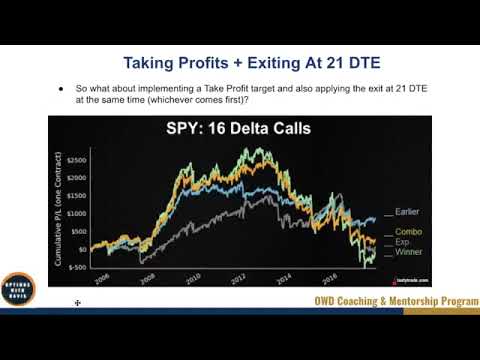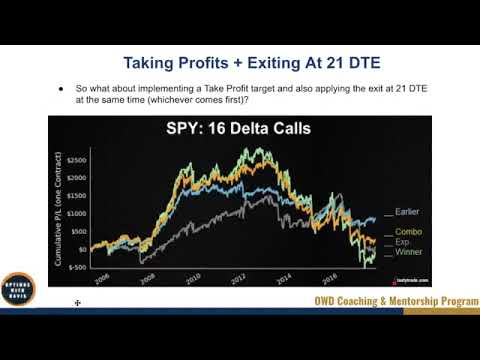In this video, titled “2-7 Trade Management Part 3 Take Profit + 21 DTE,” we will continue exploring trade management strategies. Specifically, we will focus on the concept of having a take profit target in addition to exiting at 21 DTE (days to expiration). This combination allows traders to lock in profits if the target is reached before 21 DTE, while still utilizing the effective risk management strategy of exiting at 21 DTE. The video will discuss research conducted by the tasty trade team, which shows that implementing a take profit target alongside the 21 DTE exit can lead to better performance for certain strategies. It will also emphasize the importance of risk management and psychology in trading decisions while acknowledging that the choice of strategy ultimately depends on personal preference and trading style.
In this third installment of the trade management series, we will explore the potential benefits and drawbacks of integrating a takeprofit target in addition to exiting at 21 DTE. By analyzing studies and research conducted by the tasty trade team, we can gain insights into the effectiveness of this combination strategy compared to other traditional methods. This video aims to provide you with valuable information to help you make informed decisions in your trading strategy. Whether you choose to implement a take profit target, exit at 21 DTE, or utilize a different approach altogether, understanding the underlying principles and research findings can significantly enhance your trading performance.

Introduction to Trade Management Series
Welcome to the Trade Management Series! In this comprehensive article, we will explore the importance of trade management in options trading and discuss various strategies for effectively managing trades. Trade management plays a crucial role in mitigating risk and maximizing profits, making it an essential aspect of successful trading.
Exiting at 21 DTE
One popular trade management strategy is exiting at 21 DTE (Days to Expiration). This strategy involves closing out or adjusting trades when there are 21 days left until the options expire. By exiting positions at this point, traders can effectively manage downside risk and potentially achieve superior performance compared to holding trades until expiration.
Managing downside risk is a key objective in options trading. Exiting at 21 DTE allows traders to limit their exposure to adverse market movements, minimizing potential losses. By closing out trades before expiration, traders can avoid the unpredictable nature of the market and protect their capital.
Comparing the performance of exiting at 21 DTE with holding until expiration, studies have shown that the former often yields better results. Holding trades until expiration can be risky, as it leaves traders vulnerable to sudden market changes. Exiting at 21 DTE provides a more proactive approach to trade management, allowing traders to take profits and limit losses in a timely manner.
Take Profit + 21 DTE
In addition to exiting at 21 DTE, traders can implement a take profit target to further enhance their trade management strategy. A take profit target refers to a predetermined level at which traders close out their positions to lock in profits. By combining a take profit target with the 21 DTE exit strategy, traders can potentially achieve even better results.
The take profit target complements the 21 DTE exit strategy by allowing traders to capitalize on favorable price movements. If a trade reaches the predetermined take profit level before reaching 21 DTE, traders can secure their profits and exit the position. This approach allows traders to lock in gains and avoid potential reversals or market fluctuations that could erode their profits.
Understanding Theta Decay
To fully understand trade management in options trading, it’s essential to grasp the concept of theta decay. Theta decay refers to the gradual erosion of an option’s time value as it approaches expiration. This decay accelerates as the expiration date gets closer.
Traditional stop loss techniques that are commonly used in stock trading are not as effective in options trading due to theta decay. Options have a specific timeline, and the decay in value over time makes stop losses less reliable. Therefore, it is crucial for options traders to adopt alternative trade management strategies that account for theta decay.
Studies and Research Conducted
The tasty trade team has conducted extensive studies and research on implementing a take profit target and exiting at 21 DTE. These studies aim to evaluate the performance of different trade management strategies and provide insights into the effectiveness of each approach.
Comparisons of performance have been made across various strategies, including managing at 21 DTE, holding until expiration, and combining a take profit target with the 21 DTE exit strategy. The results have shown that using a combination of a take profit target and the 21 DTE exit strategy can often yield superior performance compared to other approaches.
Benefits of Adding a Take Profit Target
By adding a take profit target to your trade management strategy, you can enjoy several benefits. First and foremost, it allows you to lock in profits when your target is reached. This can be particularly advantageous if market conditions become uncertain or unfavorable, as you can secure your gains before potential reversals occur.
Additionally, incorporating a take profit target improves risk management. By setting a specific level at which you exit a trade, you can effectively limit your downside risk. This disciplined approach ensures that you always have a clear exit strategy in place, preventing emotions from clouding your judgment.
Managing Risk and Considering Psychology
Effective trade management is closely tied to risk management. Recognizing the importance of risk management is key to successful trading. By implementing sound risk management practices, such as exiting at 21 DTE or utilizing a take profit target, traders can protect their capital and minimize potential losses.
In addition to managing risk, traders must also consider the psychological factors that can impact trading decisions. Emotions such as fear and greed can often influence one’s decision-making process. By adhering to a well-defined trade management strategy, traders can mitigate the impact of emotions and make objective decisions based on predetermined rules.
Personal Preference and Trading Strategy
When choosing between the 21 DTE exit strategy and a take profit target, traders should consider their personal preference and trading strategy. Each approach has its advantages and drawbacks, and what works for one trader may not work for another.
Factors to consider include risk tolerance, investment goals, and trading style. Some traders may prioritize capital preservation and prefer to exit positions at 21 DTE to limit risk. Others may be more aggressive and choose to implement a take profit target to capture profits quickly. Aligning the trade management strategy with personal goals and risk tolerance is crucial for long-term success.
Conclusion
In conclusion, effective trade management is essential for successful options trading. Exiting at 21 DTE provides a proactive approach to managing downside risk and often yields superior performance compared to holding trades until expiration. By incorporating a take profit target, traders can further enhance their strategy by locking in profits and improving risk management.
Understanding theta decay and the limitations of traditional stop loss techniques is crucial for options traders. By conducting thorough research and considering the findings of reputable sources such as the tasty trade team, traders can gain valuable insights into trade management strategies and make well-informed decisions.
Ultimately, the choice between the 21 DTE exit strategy and a take profit target depends on personal preference and trading strategy. Both approaches offer benefits and should be tailored to individual goals and risk tolerance. By implementing a well-defined trade management strategy and staying disciplined, traders can increase their chances of long-term success.
